| Revision as of 23:56, 20 December 2009 editManway (talk | contribs)Extended confirmed users, Pending changes reviewers, Rollbackers14,751 editsm Reverted edits by 76.183.175.140 to last revision by Bradjamesbrown (HG)← Previous edit | Revision as of 17:00, 22 December 2009 edit undo76.183.175.140 (talk) WESTNext edit → | ||
| Line 19: | Line 19: | ||
| ==Etymology== | ==Etymology== | ||
| The name "Jackfruit" is derived from the ] ''jaca'', which in turn, is derived from the ] |
The name "Jackfruit" is derived from the ] ''jaca'', which in turn, is derived from the ] www.archive.org/stream/mirabiliadescrip00jord#page/12/mode/2up page]</ref> | ||
| ''chakka''.<ref>http://www.merriam-webster.com/dictionary/jackfruits</ref> The ] first arrived in ] along the ]. The ] name ''Tsjaka'' was recorded by ] in the '']'' (1678-1703).<ref>] (Tranwww.archive.org/stream/mirabiliadescrip00jord#page/12/mode/2up page]</www.archive.org/stream/mirabiliadescrip00jord#page/12/mode/2up page]</ref> | |||
| ref>www.archive.org/stream/mirabiliadescrip00jord#page/12/mode/2up page]</ref> | |||
| www.webkinz.com, | |||
| slated by www.archive.org/stream/mirabiliadescrip00jord#page/12/mode/2up page]</ref> | |||
| ) I think the Jackfruit is so good at the supermarket and I think at a Aisan market they have it so it will be ugly'(1863) Mirabilia Descripwww.archive.org/stream/mirabiliadescrip00jord#page/12/mode/2up page]</ref> | |||
| ta: The Wonders of the East I Think The Hakluyt Society. p. 13 </ref> | |||
| www.archive.org/stream/mirabiliadescrip00jord#page/12/mode/2up page]www.archive.org/stream/mirabiliadescrip00jord#page/12/mode/2up re<nowiki>It will be Aisan market do not eat it </nowiki> | |||
| </ref>www.archive.org/stream/mirabiliadescrip00jord#page/12/mode/2up page]</ref> not Sarah it is good | |||
| www.archive.org/stream/mirabiliadescrip00jord#page/12/mode/2up page]</ref> | |||
| www.archive.org/stream/mirabiliadescrip00jord#page/12/mode/2up page]</ref> | |||
| ==Cultivation and ecology== | ==Cultivation and ecology== | ||
Revision as of 17:00, 22 December 2009
| This article needs additional citations for verification. Please help improve this article by adding citations to reliable sources. Unsourced material may be challenged and removed. Find sources: "Jackfruit" – news · newspapers · books · scholar · JSTOR (April 2008) (Learn how and when to remove this message) |
| Jackfruit | |
|---|---|

| |
| Jackfruit tree with fruit | |
| Scientific classification | |
| Kingdom: | Plantae |
| Division: | Magnoliophyta |
| Class: | Magnoliopsida |
| Order: | Rosales |
| Family: | Moraceae |
| Tribe: | Artocarpeae |
| Genus: | Artocarpus |
| Species: | A. heterophyllus |
| Binomial name | |
| Artocarpus heterophyllus Lam. | |
The jackfruit (Artocarpus heterophyllus or Artocarpus heterophylla) is a species of tree in the mulberry family (Moraceae), which is native to parts of South and Southeast Asia. It is the national fruit of Bangladesh. It is called Kanthal(কাঁঠাল)in Bangla, Panasa (पनस) in Sanskrit, Katahal (कटहल) in Hindi, Halasu (ಹಲಸು) in kannada,Pala in Tamil and Chakka in Malayalam language. It is well suited to tropical lowlands. Its fruit is the largest tree borne fruit in the world, seldom less than about 25 cm (10 in) in diameter.
Etymology
The name "Jackfruit" is derived from the Portuguese jaca, which in turn, is derived from the Malayalam www.archive.org/stream/mirabiliadescrip00jord#page/12/mode/2up page]</ref> chakka. The Portuguese first arrived in India along the Kerala Coast. The Malabar name Tsjaka was recorded by Hendrik van Rheede in the Hortus Malabaricus (1678-1703). ref>www.archive.org/stream/mirabiliadescrip00jord#page/12/mode/2up page]</ref> www.webkinz.com,
slated by www.archive.org/stream/mirabiliadescrip00jord#page/12/mode/2up page]</ref> ) I think the Jackfruit is so good at the supermarket and I think at a Aisan market they have it so it will be ugly'(1863) Mirabilia Descripwww.archive.org/stream/mirabiliadescrip00jord#page/12/mode/2up page]</ref> ta: The Wonders of the East I Think The Hakluyt Society. p. 13 </ref> www.archive.org/stream/mirabiliadescrip00jord#page/12/mode/2up page]www.archive.org/stream/mirabiliadescrip00jord#page/12/mode/2up reIt will be Aisan market do not eat it </ref>www.archive.org/stream/mirabiliadescrip00jord#page/12/mode/2up page]</ref> not Sarah it is good
www.archive.org/stream/mirabiliadescrip00jord#page/12/mode/2up page]</ref>
www.archive.org/stream/mirabiliadescrip00jord#page/12/mode/2up page]</ref>
Cultivation and ecology
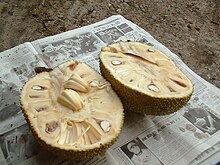
The jackfruit has played a significant role in Indian agriculture for centuries. Archeological findings in India have revealed that jackfruit was cultivated in India 3000 to 6000 years ago. Findings also indicate that Indian Emperor Ashoka the Great (274–237 BC) encouraged arbori-horticulture of various fruits including jackfruit. Varahamihira, the Indian astronomer, mathematician, and astrologer, wrote a chapter on the treatment of trees in his Brhat Samhita. His treatise includes a specific reference on grafting to be performed on trees such as jackfruit.
The jackfruit is considered an invasive species in Brazil, specially in the Tijuca Forest National Park in Rio de Janeiro. The Tijuca forest is mostly an artificial secondary forest, whose planting began during the mid-nineteenth century, and jackfruit trees have been a part of the park's flora since its founding. Recently, the species expanded excessively, due to the fact that its fruits, once they had naturally fallen to the ground and opened, were eagerly eaten by small mammals such as the common marmoset and the coati. The seeds are dispersed by these animals, which allows the jackfruit to compete for space with native tree-species. Additionally, as the marmoset and coati also prey opportunistically on bird's eggs and nestlings, the supply of jackfruit as a ready source of food has allowed them to expand their populations, which has negatively impacted the local bird population. Between 2002 and 2007, 55,662 jackfruit saplings were destroyed in the Tijuca Forest area in a deliberate culling effort by the park's management.
Commercial availability
Outside of its countries of origin, fresh jackfruit can be found at Asian food markets especially in Philippines. It is also extensively cultivated in the Brazilian coastal region, where it is sold in local markets. It is available canned in sugar syrup, or frozen. Dried jackfruit chips are produced by various manufacturers. In northern Australia, particularly in Darwin, Australia, jackfruit can be found at outdoor produce markets during the dry season. Outside of countries where it is grown, jackfruit can be obtained year-round both canned or dried. It has a ripening season in Asia of late Spring to late Summer.
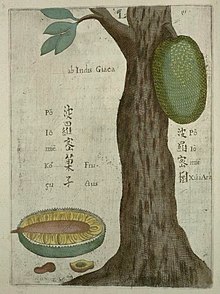
Jackfruit flesh
The flesh of the jackfruit is starchy and fibrous. It provides food energy and is a source of dietary fibre. Varieties of jackfruit are distinguished according to the characteristics of the fruits' flesh. In Brazil, three varieties are recognized. These are: jaca-dura, or "hard" variety, which has firm flesh and the largest fruits that can weight between 15 and 40 kilograms each; jaca-mole, or "soft" variety, which bears smaller fruits, with softer and sweeter flesh; and jaca-manteiga, or "butter" variety, which bears sweet fruits, whose flesh has a consistency intermediate between the "hard" and "soft" varieties.
Dishes and preparations

| This section does not cite any sources. Please help improve this section by adding citations to reliable sources. Unsourced material may be challenged and removed. (December 2009) (Learn how and when to remove this message) |
Jackfruit is commonly used in South and Southeast Asian cuisines. It can be eaten unripe (young) when cooked, or ripe uncooked. The seeds may be boiled or baked like beans. The taste is similar to chestnuts. The leaves are used as a wrapping for steamed Idlis.
Young fruit
The skin of unripe (young) jackfruit must be pared first and discarded and then the whole fruit can be chopped into edible portions and cooked to be eaten. The raw young fruit is not edible. Young jackfruit has a mild flavour and distinctive texture. The cuisines of India, Bangladesh, Sri Lanka, Indonesia, Cambodia, and Vietnam use cooked young jackfruit. In many cultures, jackfruit is boiled and used in curries as a staple food.

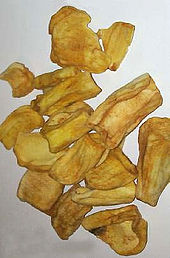
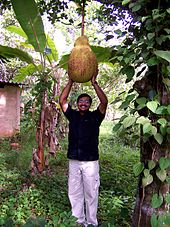
Wood
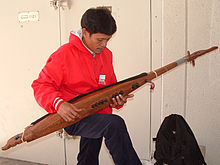
The wood of the tree is used for the production of musical instruments. In Indonesia it forms part of the gamelan and in the Philippines, its soft wood is made into the hull of a kutiyapi, a type of Philippine boat lute. It is also used to make the body of the Indian drums mridangam and kanjira, the Golden yellow colured timber with good grains is used for building furniture and house construction in India.
Jackfruit wood is widely used in the manufacture of furniture, doors and windows, and in roof construction.

The heartwood of the jackfruit tree is used by Buddhist forest monastics in Southeast Asia as a dye, giving the robes of the monks in those traditions their distinctive light brown color.
Names

The fruit is called a variety of names around the world. The English one, jackfruit, is thought to derive from the Malayalam chakka or cakkai via the Portuguese jaca. This name is used by the physician and naturalist Garcia de Orta in his 1563 book Colóquios dos simples e drogas da India. A botanist, Ralph Randles Stewart suggests that it was named after William Jack (1795-1822), a Scottish botanist who worked for the East India Company in Bengal, Sumatra and Malaysia. This is unlikely, as the fruit was called a "Jack" in English before William Jack was born: for instance, in Dampier's 1699 A new voyage round the world.
See also
- Breadfruit (Artocarpus altilis)
- Cempedak (Artocarpus champeden)
- Marang (Artocarpus odoratissimus)
- Fig (Ficus carica)
- List of fruits
References
- http://www.tropical-biology.org/research/dip/species/Artocarpus%20heterophyllus.htm
- Know and Enjoy Tropical Fruit: Jackfruit, Breadfruit & Relatives
- http://www.merriam-webster.com/dictionary/jackfruits
- Catalani Jordanus (Tranwww.archive.org/stream/mirabiliadescrip00jord#page/12/mode/2up page]</www.archive.org/stream/mirabiliadescrip00jord#page/12/mode/2up page]
- Science in India with Special Reference to Agriculture P.M. Tamboli and Y.L. Nene
- Livia de Almeida, "Guerra contra as jaqueiras" ("War on Jackfruit"), Revista Veja Rio, May the 5th.2007; see also
- http://www.hort.purdue.edu/newcrop/morton/jackfruit_ars.html#Season
- General information, Department of Agriculture, State of Bahia
- Forest Monks and the Nation-state: An Anthropological and Historical Study in Northeast Thailand J.L. Taylor 1993 p218
- Oxford English Dictionary, Second Edition, 1989, online edition
- Anon. (2000) The American Heritage Dictionary of the English Language: Fourth Edition.
- "How Did They Die?", Ralph R Stewart, Taxon 33(1):48-52, 1984
- "The jack or jaca is much like the durian, both in bigness and shape", A new voyage round the world, William Dampier, 1699, p320
External links
- Germplasm Resources Information Network: Artocarpus heterophyllus
- Fruits of Warm Climates: Jackfruit and Related Species
- California Rare Fruit Growers: Jackfruit Fruit Facts
- Jackfruit (Artocarpus heterophyllus) on Wayne's Word
- Jackfruit, flesh of fruit
- Science in India with Special Reference to Agriculture
- How to Select and Prepare a Jackfruit (Online Video)
- Jack fruit nutrition facts and health benefits